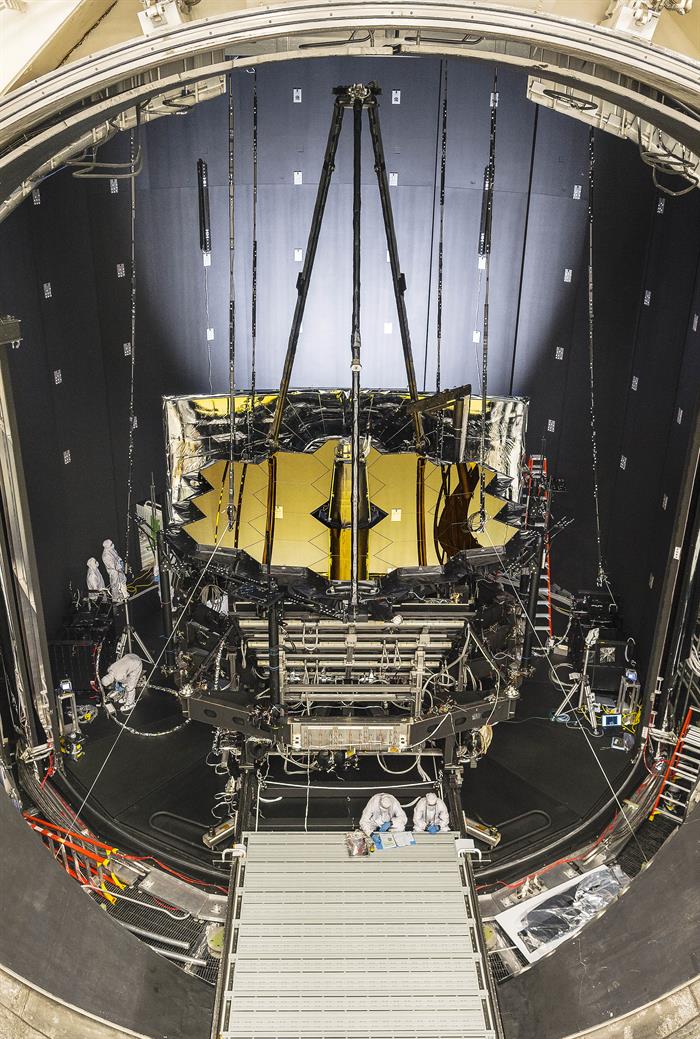A French team took part in the full-scale tests recently completed on the James Webb Space Telescope (Webb), the successor to the Hubble Space Telescope. Webb is a programme being led by NASA in partnership with Europe (through the European Space Agency, or ESA) and Canada.
For these cryogenic tests, which began on August 22nd and ended on September 26th, the telescope and its instruments were placed inside the giant vacuum chamber (Chamber A) at NASA's Johnson Space Center in Houston, Texas. This is the only cryogenic chamber in the world large enough to house the telescope and its 6.5-metre mirror (by comparison, Hubble's mirror spans just 2.4 metres). Then, Webb was slowly heated up and pressurized again to allow the reopening of the chamber.
Inside the chamber, the temperature is cooled to as low as –253°C. The chamber also has a star simulator, a device consisting of several mirrors and infrared light sources used to verify the optical quality and alignment of Webb's mirror by comparing actual images obtained with simulated ones. This is the first time the telescope and instruments have been tested together. The instruments had previously undergone a series of three cryogenic tests on their own inside a smaller chamber (the Space Environment Simulator) at NASA's Goddard Space Flight Center in Greenbelt, Maryland, from 2013 to 2016. "A number of French research laboratories are closely involved in one of the four instruments on Webb, the Mid-InfraRed Instrument (MIRI), and more especially its Mid-InfraRed IMager (MIRIM)," says Anne Peyroche, President of CNRS, the French scientific research centre. They are the LESIA space and astrophysics instrumentation research laboratory (Paris Observatory-CNRS-UPMC-Paris Diderot University), the LAM astrophysics laboratory in Marseille (CNRS-AMU), the IAS space astrophysics institute (CNRS-Paris Sud University) and the AIM astrophysics joint research unit (CEA-CNRS-Paris Diderot University), with CEA's Institute of research into the fundamental laws of the Universe (Irfu) as prime contractor. Oversight is being assured by CNES.
Calling Houston: from Apollo to Webb
The chamber in Houston where the Webb telescope underwent these cryogenic tests also has a rich and highly symbolic scientific legacy of advancing science and technology. Known as Chamber A and located at NASA's Johnson Space Center, it was initially developed for the Apollo programme. It was given a major refurbishment to enable it to simulate the harsh environmental conditions Webb will encounter in space. Experts from the French Alternative Energies and Atomic Energy Commission (CEA) and the French scientific research centre (CNRS) took part in the recent series of tests conducted in the chamber.MIRIM was shipped from Saclay to the Rutherford Appleton Laboratory (RAL) in the United Kingdom in 2009 after undergoing a battery of tests to confirm that it matches specifications. It was then coupled with MIRI’s spectrometer, developed chiefly by The Netherlands and the United Kingdom, and subjected to a new series of cold tests before being shipped to NASA’s Goddard Space Flight Center in 2012, where MIRI was integrated with Webb’s three other instruments.
Webb's travels are not over yet, as it will next be taken to California for integration with the spacecraft and sunshield. The full Webb observatory will then be sent by sea to Kourou, French Guiana, where Jean-Yves Le Gall, President of CNES, which is overseeing MIRI, is "eagerly awaiting the telescope, which has shown once again with the completion of cryogenic testing what international cooperation in space can achieve, for its launch atop an Ariane 5 late in the Spring of 2019." Webb will then be positioned in its final operating orbit at the L2 Lagrange point 1.5 million kilometres from Earth, that is, about four times further than the Moon. "If anything goes wrong out there, we obviously won't be able to send up a team to repair it like we did for Hubble1. That's why these final tests conducted by teams from France on the JWST and its instruments are so important," underlined Daniel Verwaerde, Chairman of CEA, the prime contractor for MIRI.
1 Hubble is in Earth orbit at an altitude of only 590 kilometres

The Webb telescope inside Chamber A at Johnson Space Center in Houston. © NASA/Chris Gunn